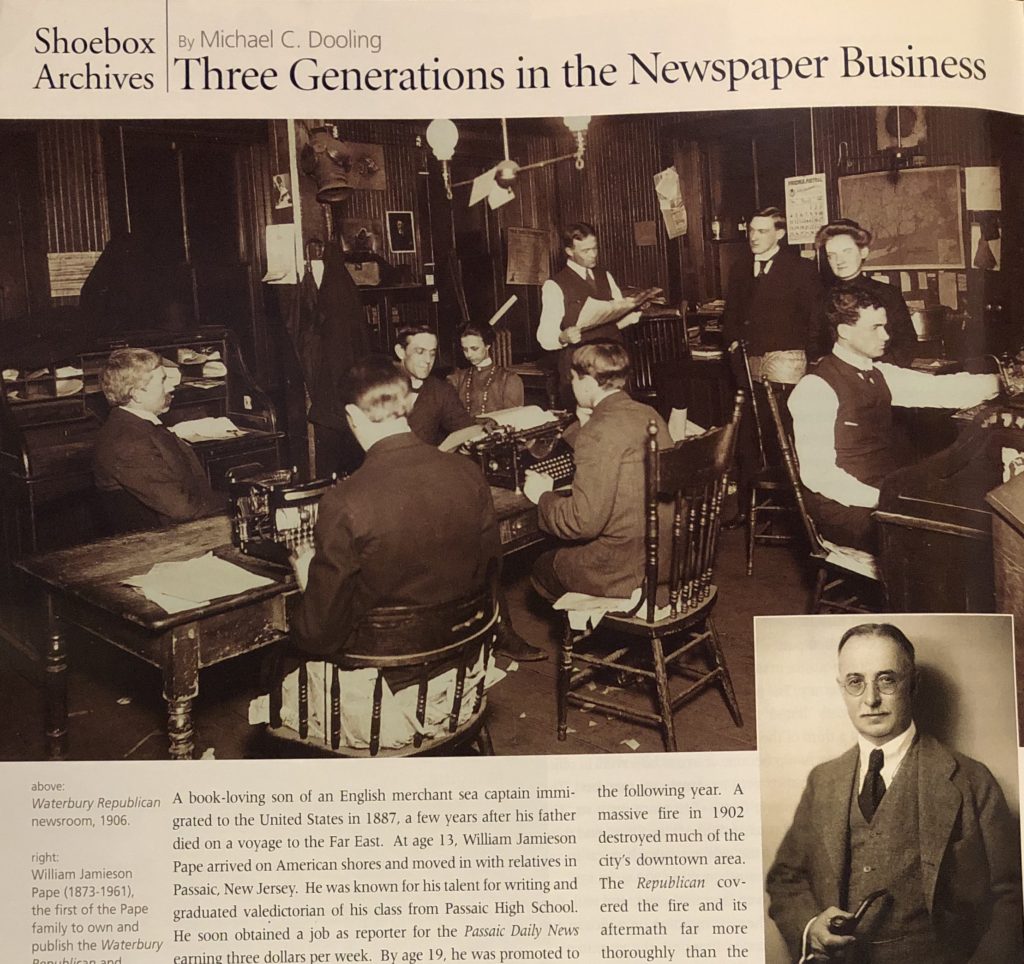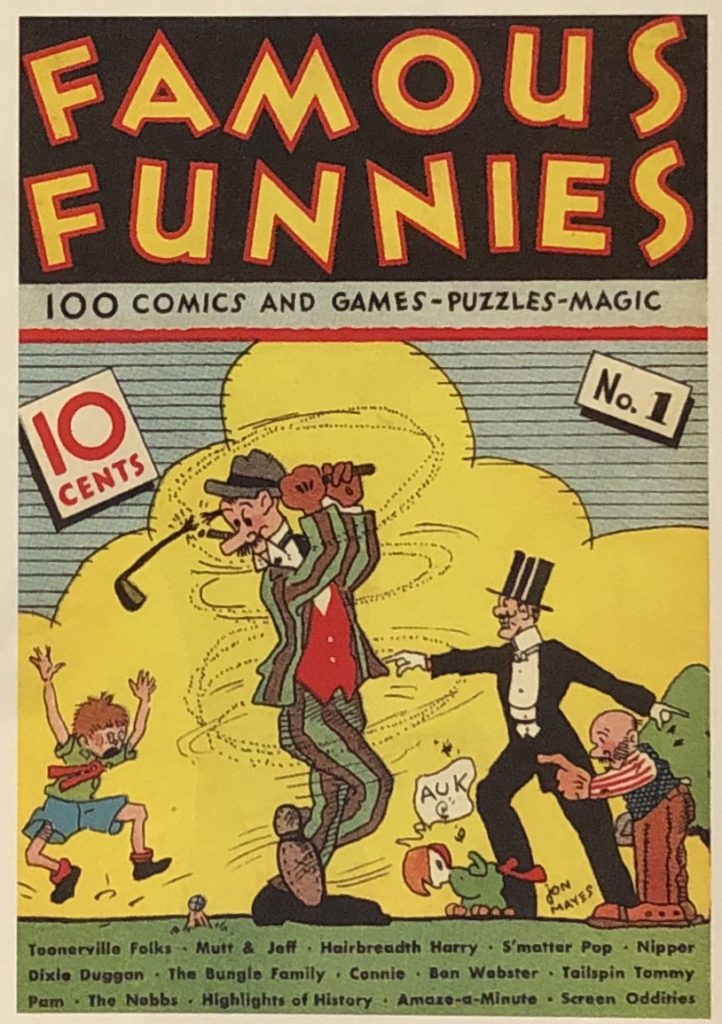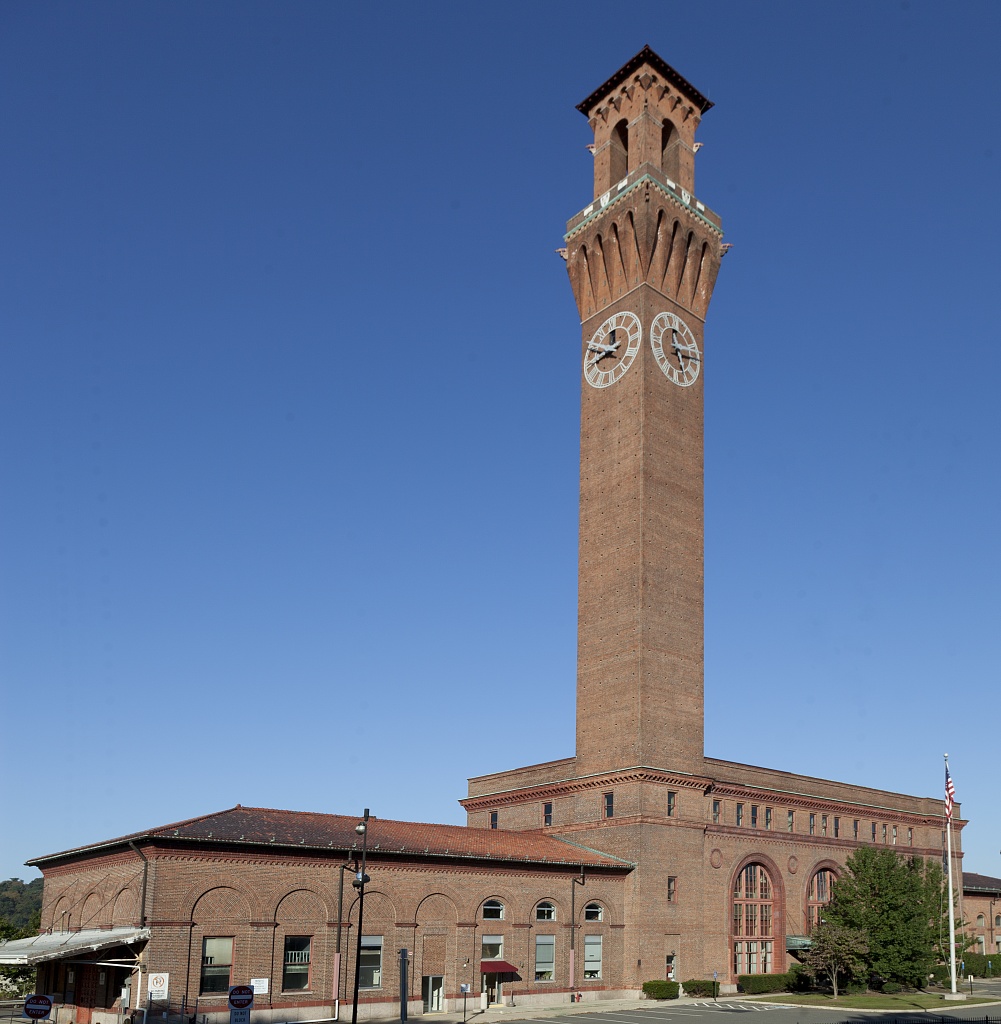
top: Waterbury Republican newsroom, 1906. right: William Jamieson Pape (1873-1961), the first of the Pape family to own and publish the Waterbury Republican and Waterbury American newspapers. Courtesy of the Republican-American, Waterbury.
By Michael Dooling
(c) Connecticut Explored Inc. Fall 2010
Subscribe/Buy the Issue!
A book-loving son of an English merchant sea captain immigrated to the United States in 1887, a few years after his father died on a voyage to the Far East. At age 13, William Jamieson Pape arrived on American shores and moved in with relatives in Passaic, New Jersey. He was known for his talent for writing and graduated valedictorian of his class from Passaic High School. He soon obtained a job as reporter for the Passaic Daily News earning three dollars per week. By age 19, he was promoted to city editor and at age 24 became the newspaper’s editor and business manager.
Pape aspired to publish his own newspaper and learned that a daily newspaper in Waterbury, Connecticut was for sale. In 1901, he formed a partnership with another newsman, Gordon Lathrop, and purchased the Waterbury Republican, a morning paper that had served Waterbury since 1884. During the first year, the Republican, which was set up against two other competitors in the city, was slow to gain circulation. But things changed the following year. A massive fire in 1902 destroyed much of the city’s downtown area. The Republican covered the fire and its aftermath far more thoroughly than the other local newspapers, and its circulation soared as a result. [See “What a Disaster,” Fall 2011.]
In 1915, the Republican faced another challenge when Pape was arrested and charged with criminal libel by State Senator James Peasley of Waterbury. Peasley claimed that Pape had maliciously printed libelous editorials about him over a city court bill that would have benefitted him personally. Through the case went to trial, the judge ruled there wasn’t sufficient legal basis for the lawsuit.
Pape became sole owner of the Republican and in 1922 acquired the Waterbury American, an afternoon paper and Waterbury’s first, founded in 1844. The two newspapers continued to be printed until 1990, when they merged and the names combined on the masthead of a single morning newspaper.

Famous Funnies No. 1, 1934, printed by Eastern Color Printing Company, which was also owned by the Pape family. Courtesy of the Republican-American, Waterbury.
In 1924, the Republican and American had begun printing their comics pages in color and started selling their color-printing services to other newspapers. Pape founded a separate company, Eastern Color Printing Company, in 1930 to oversee that end of the business. In 1934, Pape’s new company produced what is considered by many to be the first American comic book, named Famous Funnies, featuring the adventures of Mutt and Jeff, Donald Dare, Buck Rogers, and other comic characters.
Something else was funny in Waterbury in the 1930s. Pape became suspicious of a sudden rise in voter registrations in the city. He directed the Republican and American reporters to start digging, and they found plenty of dirt: registration lists containing names of voters who had died or who had long ago left the town. As a result of the reporters’ efforts, the Democratic and Republican registrars of voters were removed from office.
Pape also questioned the honesty and integrity of Waterbury’s mayor, T. Frank Hayes. Hayes held two offices at the time; he had been mayor of Waterbury since 1930 and Connecticut’s lieutenant governor since 1935. The city had slipped deeper into debt during the Hayes administrations. The city’s unusually high tax rate didn’t seem to offset the debt. In 1937, Sherwood Rowland, former Governor John Rowland’s grandfather, was elected city comptroller. He quickly uncovered a scandal involving millions of dollars illegally funneled to Hayes and his cohorts. The following year, a grand jury indicted 27 individuals for conspiracy and fraud. Twenty-three of them were convicted in what was Connecticut’s longest trial on record.
In 1928, Pape told his reporters, “We have no sacred cows. No one can keep his name out of our papers if it belongs there.” His philosophy paid off for the city of Waterbury and for the newspaper. In 1940, as a result of the papers’ unceasing coverage of the Hayes administration’s scandals, the Waterbury Republican and American were awarded the Pulitzer Prize for Meritorious Pubic Service.
The Republican-American headquarters is now located in the city’s former Union Station, built in 1909 for the New Haven Railroad. The building was designed by the renowned architectural firm McKim, Mead, and White. Its base is made of Stony Creek pink granite; the herringbone, vaulted ceilings are constructed with Guastavino tiles (also used in New York’s Grand Central Station and the adjacent Oyster Bar): and the station’s prominent clock tower, embellished with eight gargoyles, was modeled after the Torre de Mangia on the Palazzo Pubblico in Siena, Italy. The Pape Family purchased the building in 1952 to house their growing newspapers and renovated it to suit its new use. With its 240-foot bell and clock tower, the Republican-American headquarters dominates the Waterbury skyline and is the landmark building for everyone who passes through the city.

Waterbury’s former Union Station, headquarters of the Republic-American newspaper. photo: Carol M. Highsmith, Library of Congress
Pape maintained his position as editor and publisher until his death in 1961, when the reins passed to his son, William B. Pape, who served until 1972. His grandson, William J. Pape II, grew up in the newspaper business, graduated from the United States Naval Academy and Harvard Business School, and has been publisher since 1972.
Over the years, the newspaper extended its coverage area to include 36 towns in the northwest corner of the state. The Republican-American is one of a handful of daily family-owned Connecticut newspapers and one of the oldest in the state.
The same challenges that affect all newspapers are now facing the Republican-American. Circulation declines, competition from Internet news sources, advertising dollars being spent in digital venues, and the increasing cost of newsprint are threats to all newspapers. Yet, only local newspapers report community news, a commodity that is only available on the Internet by virtue of the work of newspapers’ beat reporters. If newspapers were to disappear, there would be a hug gape in local news coverage, something an educated public may not tolerate.
William Jamieson Pape used to tell his staff, “Every day our work must pass muster with the public.” The Republican-American newspapers have done so successfully for more than 160 years. But that’s yesterday’s news. Today’s news cycle has already begun, and tomorrow the public will be the judge once again.
Michael C. Dooling was the news librarian for the Waterbury Republican-American and is the author of three books: An Historical Account of Charles Island, Milford Lost & Found, and his most recent Clueless in New England: The Unsolved Disappearances of Paula Welden, Connie Smith and Katherine Hull.
Explore!
Waterbury’s “Frankies Hot Dogs”
“Longer Lasting than Brass: Waterbury’s City Hall Restored”
“Womens Suffrage in Waterbury”
“TIMEX: Takes a Licking and Keeps on Ticking”
“The Brass City Manufactures for Victory,” Fall 2007
